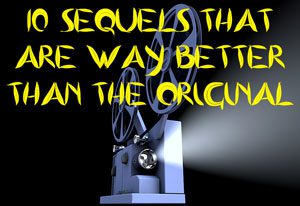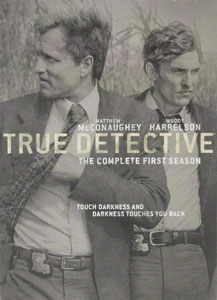Even in a decade that has seen many elite examples of the short-form detective series – from “Fargo” to “Sharp Objects,” from “The Killing” to “I Am the Night” – “True Detective” Season 1 (2014, HBO) takes the cake. And eats it, too. After all, as Detective Marty Hart (Woody Harrelson) would say, “What else are you gonna do with cake except eat it?”
Character piece disguised as a crime series
Featuring eight hour-long episodes, “True Detective” Season 1 is a crime mystery in structure but ultimately a masterpiece of a character study. The dialog is part of the equation for building a complete picture of rural Louisiana detective Marty and his partner, Rust Cohle (Matthew McConaughey). One-liners are a reliable approach, and sometimes they have darker meaning, like Rust’s response to Marty’s getting-to-know-you question about whether his mom is still living: “Maybe.”
Another approach is Rust’s monologues, like when the duo is standing at the back of a religious revival tent and Rust calmly unloads about how religion is one of the most pathetic traits of humanity. Rust is one of the all-time great TV detectives even though the bulk of his scenes consist of him sitting at a table while being questioned by two young detectives in present-day 2012 about the epic serial-murder case that started back in 1995. The empty beer cans pile up and the ashtray fills, but Rust isn’t a parody of a cop who has seen too much. He took this job because it fit his personality.

“True Detective” Season 1 (2014)
Eight episodes, HBO
Creator: Nic Pizzolatto
Stars: Woody Harrelson, Matthew McConaughey, Alexandra Daddario
Marty, meanwhile, fits the mold of the cop whose life is being destroyed by his inability to separate work from his home life. Whenever I see TV wives (Michelle Monaghan’s Maggie in this case) disappointed by their cop or military husband becoming distant, I always think “Well, what did you expect?” But this is nonetheless a prime example of the situation.
Entirely written by Nic Pizzolatto (who had written a couple episodes of “The Killing”) and directed by Cary Joji Fukunaga, “True Detective” Season 1 is a masterful portrait of two intertwined people who hate each other’s guts, yet Marty and Rust don’t have arcs where they grow and change.
Journey through the years
We meet them as 30-somethings and follow them into their 50s (the makeup designers especially sell this with the hairstyles on McConaughey, from professional in 1995 to I-don’t-care in 2012, along with an I-don’t-give-a-shit mustache). They stay the same on the inside, which is true of most human beings. Rust accepts this, Marty fights it.
When Rust – whose lifestyle is so ascetic he makes Jessica Jones look like a furniture hoarder — quits in 2002 and takes up tending bar, working four days a week and drinking the other three, he is doing what he believes he was meant to do. “And there’s a victory in that,” he tells the pair of younger detectives in 2012.

Marty, by contrast, is perpetually bothered by his personal failings – most memorably his womanizing, particularly in a scene with Alexandra Daddario’s Lisa in episode two where he delivers the “cake” comment. His mistress is his buffer between work and home — and that’s not merely an excuse, it’s an accurate observation, even if it can’t be accepted by Maggie or any normal person as a valid excuse.
He’s almost like a good person puppeteered by a bad person, as nicely illustrated when his most horrific action – beating up two dumb kids in a jail cell who had sex with his teenage daughter – is followed by him vomiting in the parking lot.
Further from normal
“True Detective” takes us further from normal as it goes along, yet always stays grounded because the lenses of Marty and Rust are so well-established. It starts off with a grisly tableau straight out of “Hannibal”: a deceased nude woman posed as praying to a tree with antlers on her head. In terms of what we see on the screen, this HBO series is ultimately tamer than NBC’s “Hannibal,” but the fact that it’s less nutso arguably makes it creepier.
As “True Detective” ratchets up its “can’t look away” momentum, I wonder if things like what’s portrayed here go on in the real southern swamps of Louisiana. The location scouting (in Louisiana itself) and set designs are so evocative that a viewer can’t help but wonder about that as we encounter places such as a “bunny ranch” (home for prostitutes) deep in the woods – and much creepier places later on. “True Blood” is a cartoon in comparison.
“True Detective” reminds me of the novels of Preston & Child; those authors are always finding primitive, barely explored corners of the Earth. You can look at a map of Louisiana — and Rust certainly does that, marking murder locations in red pen. But when the detectives drive into the swamplands — which Rust notes will be underwater in 30 years in one of his classic non sequiturs — you have to wonder if a surveyor has ever set foot there.
And, continuing that line of thought, you wonder what a human being could get away with if not governed by any of their own morality, let alone by any government jurisdictions. “True Detective” dreams up a creepy possibility, but it transcends its horror trappings by showing the cost to the psyches of two men who dare to tread into the swamplands.

